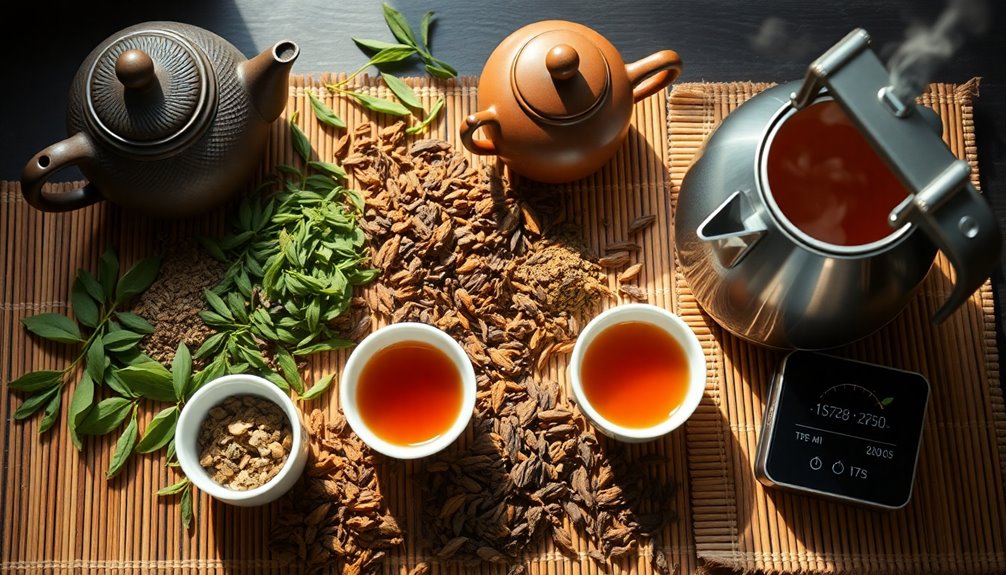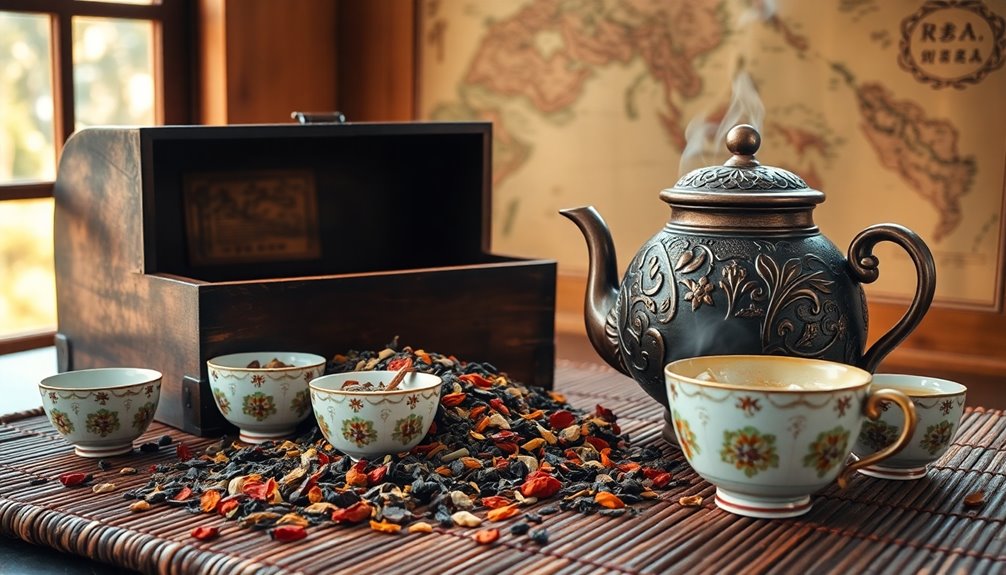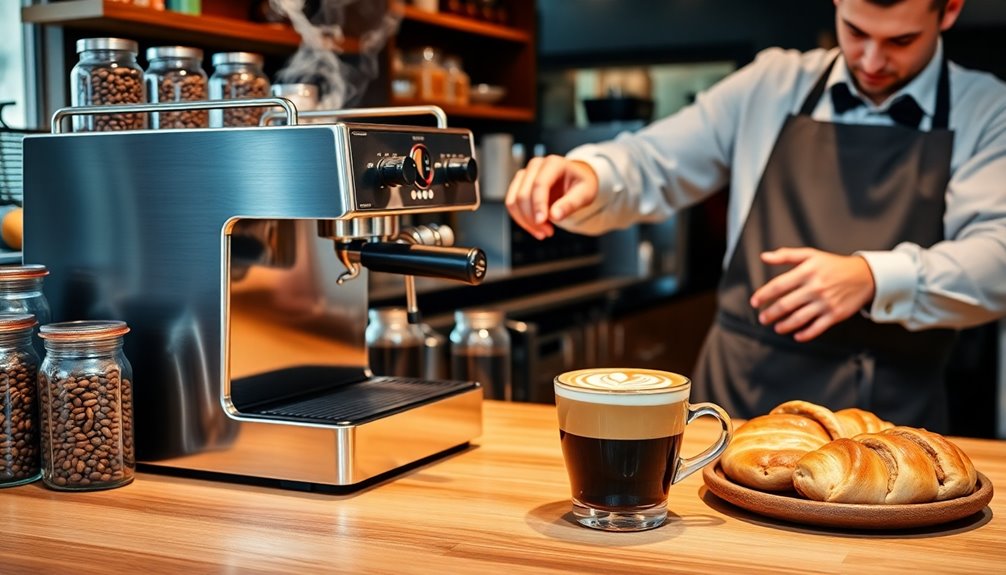Tea's history is rich and intriguing, starting with its discovery by Emperor Shen Nong around 2737 BCE in China. As you explore its evolution, you'll find how it transformed from a luxury item during the Tang dynasty to a global staple today. Cultural practices like the Japanese tea ceremony and British afternoon tea showcase its social significance. Different varieties, from green to herbal, add to its diversity. Over time, innovations like tea bags and sustainable practices emerged, impacting production and consumption. There's a whole world behind your cup of tea, just waiting for you to uncover more details.
Key Takeaways
- Tea was discovered by Emperor Shen Nong around 2737 BCE, originating from the leaves of Camellia sinensis.
- The Tang dynasty implemented a tea tax, highlighting tea's status as a luxury item in society.
- Japanese monk Saichō introduced tea to Japan in the 9th century, leading to the establishment of tea plantations.
- The industrialization of tea production introduced mechanization, facilitating mass production and making tea accessible to the middle class.
- Modern innovations in tea include artisan blends and the rise of herbal teas, catering to health-conscious consumers and enhancing the tea experience.
Historical Origins of Tea

Tea's fascinating journey began around 2737 BCE when Emperor Shen Nong accidentally discovered it after leaves from the camellia sinensis plant infused in his boiling water. This marked the start of the history of tea, highlighting its cultural importance in ancient China.
By the Han dynasty, tea containers were found in tombs, indicating its valued role in society. The Tang dynasty saw tea's popularity soar, with the introduction of a government-imposed tea tax reflecting its status as a luxury item.
In the early 9th century, Japanese monk Saichō brought tea to Japan, paving the way for small tea plantations and ceremonial practices.
European exposure to tea in the 17th century further solidified its allure among the wealthy in cities like Amsterdam and London.
Cultural Significance and Rituals

While many people enjoy tea for its flavor, its cultural significance and rituals reveal a deeper connection to society and tradition.
In Japan, the tea ceremony embodies mindfulness, harmony, and hospitality, creating meaningful social interactions. Similarly, Chinese tea ceremonies emphasize a connection with nature, reflecting the beverage's spiritual importance.
In India, chai tea serves as a warm gesture of hospitality, symbolizing welcome and community. Turkish tea culture fosters daily social interactions, where refusing tea is seen as impolite.
The British afternoon tea tradition, popularized by the Duchess of Bedford, bridges gaps between meals and enhances social gatherings.
These rituals illustrate tea consumption's role in nurturing connections, reinforcing customs, and celebrating shared experiences across cultures.
Varieties of Tea

When exploring the world of tea, you'll discover a rich diversity that caters to various tastes and preferences.
All true teas stem from the Camellia sinensis plant, with green tea made from unoxidized leaves, offering a light flavor and high antioxidant content.
Black tea, on the other hand, undergoes full oxidation, resulting in a robust flavor and deep color.
Oolong tea strikes a balance between the two, showcasing floral and fruity notes through partial oxidation.
White tea, the most delicate, consists of young leaves and buds, featuring a subtle sweetness and impressive antioxidant levels.
Don't forget herbal teas, which aren't true teas but infusions from various herbs and spices, providing an exciting range of flavors and potential health benefits.
Evolution of Tea Production

As tea has evolved over the centuries, so too have the methods of its production, transforming from labor-intensive processes to modern, automated techniques.
Initially, tea production relied heavily on manual labor, with workers meticulously plucking and processing leaves. However, the introduction of automation has streamlined tasks like withering, rolling, and drying, enhancing both efficiency and quality control.
The rise of tea bags in the early 20th century offered convenience, changing how you consume tea.
Nowadays, sustainable practices, including organic farming and ethical sourcing, reflect your demand for environmentally friendly options.
The global tea market has seen remarkable growth, with specialty tea sales skyrocketing, emphasizing the shift towards diverse, high-quality offerings that cater to refined tastes.
Impact of Industrialization

Industrialization transformed the tea industry, revolutionizing how tea is produced and consumed.
You witnessed the mechanization of processes like plucking, withering, rolling, and drying, which greatly boosted production efficiency. The introduction of steam-powered tea clipper ships sped up transportation, reshaping the global tea trade and slashing shipping times.
Mass production techniques and large plantations turned tea into an accessible commodity for the burgeoning middle class. The rise of tea bags in the early 20th century brought convenience, leading to a decline in loose leaf tea consumption.
Additionally, standardized packaging and labeling facilitated global distribution, paving the way for branded tea products.
Global Tea Consumption Trends

As you explore global tea consumption trends, you'll notice significant shifts in preferences, especially towards health-conscious options.
More people are turning to herbal and functional teas, seeking specific benefits that align with their wellness goals.
This growing demand for innovative blends and ready-to-drink options is reshaping the tea market in exciting ways.
Shifts in Preferences
There's been a noticeable shift in global tea consumption trends as consumers increasingly prioritize convenience and health.
This evolution reflects your desire for quick, flavorful options that fit your lifestyle.
- The rise of ready-to-drink iced tea now accounts for about 80% of total U.S. tea sales.
- Herbal teas and spice-infused varieties are popularizing tea as a wellness drink.
- Loose leaf tea is giving way to innovative brewing methods that cater to modern consumer convenience.
- Online platforms enable global exploration of unique blends from diverse cultures.
These trends highlight how the tea market is adapting to your preferences, emphasizing ease, health benefits, and the joy of discovering new flavors.
Health-Conscious Consumption Trends
With a growing emphasis on health and wellness, consumers are increasingly turning to tea as a go-to beverage for its numerous benefits.
The specialty tea market has flourished, driven by health-conscious individuals seeking wellness-oriented beverages. Green tea, renowned for its metabolism-boosting and heart health benefits, has gained immense popularity. Additionally, herbal teas such as chamomile and peppermint are sought after for their ability to promote relaxation and reduce muscle tension, appealing to those with specific health needs. Research has shown that certain herbal teas can also provide antioxidant properties, further enhancing their appeal. Herbal teas, including varieties like ginger and echinacea, are often used for their medicinal purposes, addressing various health concerns. Furthermore, the global tea market was valued at approximately $200 billion in 2022, highlighting the beverage's significant economic impact.
Alongside it, herbal teas and fermented tea varieties have attracted those valuing their antioxidant properties and potential health benefits.
The rise of ready-to-drink teas shows a shift in consumer preferences, favoring convenience without compromising health.
Online platforms further enhance your tea journey, allowing you to explore rare and specialty varieties, deepening your appreciation for tea's diverse health benefits. Research suggests that tea consumption is also linked to improved cognitive function, making it a favorable choice for mental wellness.
It's clear: tea is now a staple in health-conscious lifestyles.
Tea Etiquette Worldwide

When you enjoy tea around the world, you'll find that etiquette varies greatly from one culture to another.
In some places, like Turkey, refusing tea can be seen as rude, while in Japan, silence and ritual enhance the experience.
Understanding these customs can enrich your appreciation of tea and its significance in different societies.
Cultural Variations in Etiquette
Understanding tea etiquette worldwide reveals the rich tapestry of cultural practices associated with this beloved beverage. Each region has its unique customs and traditions that shape the way tea is appreciated and consumed.
- In China, bowing and finger-tapping show appreciation.
- Japanese tea ceremonies emphasize silence and sweets before matcha.
- In Australia and the UK, slurping tea is impolite, and scones should be torn, not cut.
- In Turkey, declining tea is considered rude, while in India, it's acceptable to decline the first offer.
These cultural norms highlight the importance of etiquette in tea consumption, showcasing the beautiful variations that exist globally.
Embracing these differences enhances your understanding and enjoyment of tea, making it a truly universal drink.
Common Practices and Rituals
Tea rituals and practices vary widely across cultures, reflecting deep-rooted traditions and social norms.
In China, you show appreciation by tapping your fingers on the table after being served, a gesture of respect.
Japanese tea ceremonies emphasize mindfulness, where you remove your shoes and enjoy sweets before sipping matcha.
In Turkey, refusing tea is impolite, highlighting its role in fostering social connections.
Meanwhile, in India, guests may politely decline the first offer of chai.
Proper tea etiquette in Australia and the UK involves avoiding slurping and holding the teacup correctly.
In Argentina, swirling mate disrupts the communal nature of sharing.
Each of these rituals enriches your tea drinking experience and strengthens social bonds among guests.
Modern Innovations in Tea

As consumers seek more convenient and flavorful options, modern innovations in tea have transformed the way people enjoy this age-old beverage.
Contemporary brands focus on artisan, whole leaf tea blends, catering to health-conscious consumers with premium offerings. Iced tea remains a staple, especially since its rise in popularity after the 1904 World's Fair.
You'll find several key trends in today's tea market:
- Innovative brewing methods, like cold brewing and single-serve systems
- A surge in herbal teas and functional blends promoting wellness
- Emphasis on high-quality, globally sourced ingredients
- Increased convenience for busy lifestyles
These advancements not only enhance flavor but also align with the growing interest in health and quality among tea drinkers.
Frequently Asked Questions
What Is the Story Behind the Origin of Tea?
The story behind the origin of tea starts with Emperor Shen Nong in 2737 BCE.
One day, as he boiled water, leaves from the Camellia sinensis plant accidentally fell in. Curious, he tasted the infusion and discovered its invigorating qualities.
Initially used for medicinal purposes, tea quickly became a cultural symbol in ancient China, evolving into a beloved beverage that would spread across continents, transforming societies and rituals along the way.
What Are the Two Theories Regarding the Origin of Tea?
You'll find two main theories on tea's origin.
The first suggests that ancient China is the birthplace, dating back to around 2737 BCE when Emperor Shen Nong accidentally brewed tea by adding leaves to boiling water.
The second theory points to Tibet or Northern India, where tribes brewed leaves from various plants long before tea became popular in China.
Both theories highlight tea's early use as a medicinal and social beverage.
What Is the Origin Point of Tea?
Tea's origin point is like a hidden gem waiting to be discovered. It traces back to ancient China around 2737 BCE, when Emperor Shen Nong stumbled upon it after a leaf drifted into boiling water.
Initially valued for its medicinal qualities, tea soon blossomed into a daily ritual. As you sip your cup, remember that you’re holding a piece of history, connecting you to centuries of tradition and cultural significance. Throughout the ages, tea has transcended its original purpose, evolving into a symbol of hospitality and community. With each brew, you not only indulge in its comforting warmth but also unlock the authentic quince tea benefits, known for its soothing properties and rich flavor profile. This treasured beverage invites you to slow down, reflect, and appreciate the intricate tapestry of flavors and stories woven into every cup.
How Did Tea Change History?
Tea's had a profound impact on history. You can see how it spurred economic shifts, influenced social customs, and even ignited protests like the Boston Tea Party.
It became a symbol of status in Europe, transforming gatherings into refined social events. As trade disputes arose over tea, you realize its role in shaping international relations.
Conclusion
As you sip your favorite brew, remember that tea's journey spans centuries and continents, intertwining cultures and traditions. From ancient rituals to modern innovations, each cup tells a story steeped in history. It's fascinating how this beloved beverage has evolved, adapting to our changing tastes and lifestyles. So, whether you're enjoying a quiet moment or sharing a pot with friends, know that you're part of a rich legacy—truly a cup that runneth over with meaning and connection.










